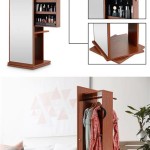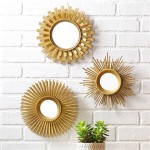Antique Wall Mirrors: A Reflection of History and Style
Antique wall mirrors offer more than just a reflection; they provide a glimpse into the past, showcasing the artistry and craftsmanship of bygone eras. These decorative pieces can elevate a room's aesthetic, adding a touch of history and sophistication to any interior design scheme. Understanding the nuances of antique mirrors, from their historical context to their various styles and identifying features, can assist collectors and enthusiasts in appreciating their value and incorporating them effectively into their homes.
The history of wall mirrors is intertwined with the development of glassmaking and mirroring techniques. Early mirrors, dating back to antiquity, were made from polished obsidian, metal, or other reflective surfaces. The development of glassblowing in the Roman Empire paved the way for crude glass mirrors, though these were often small and expensive. The true precursor to modern mirrors emerged in the 16th century in Venice, where artisans perfected the art of coating glass with a tin-mercury amalgam, creating a highly reflective surface. This Venetian dominance in mirror production led to the creation of elaborate and highly prized mirrors, often adorned with intricate frames and decorative elements.
The 17th and 18th centuries witnessed the spread of mirror-making techniques across Europe, resulting in distinct regional styles and variations. France, in particular, became renowned for its opulent Rococo and Neoclassical mirrors, featuring ornate carvings, gilding, and bevelled glass. English mirror makers also developed their own distinctive styles, often incorporating elements of Chinoiserie and Gothic Revival into their designs. The Industrial Revolution brought about significant changes in mirror production, with the introduction of mechanized processes and the use of silvering instead of mercury, allowing for the mass production of more affordable mirrors.
Identifying antique mirrors requires careful observation and attention to detail. Examining the glass itself can offer valuable clues. Early mirrors often exhibit imperfections, such as bubbles, ripples, or slight discoloration, due to the hand-blown nature of the glass. The presence of mercury backing, identifiable by a dark, often mottled appearance on the back of the glass, is a strong indicator of an older mirror. However, it is crucial to handle such mirrors with care due to the toxicity of mercury.
The frame of an antique mirror is often its most defining feature. Different periods and styles are reflected in the materials, techniques, and decorative motifs employed in frame construction. Carved wooden frames, often gilded or painted, are characteristic of many antique mirrors. The type of wood, the carving style, and the presence of specific decorative elements can help pinpoint the age and origin of the mirror. For example, acanthus leaf motifs are common in Neoclassical designs, while intricate floral carvings are indicative of the Rococo period. Other materials used in antique mirror frames include gesso, plaster, and various metals such as bronze and brass.
Determining the value of an antique wall mirror is a complex process that takes into account numerous factors. Age, rarity, condition, and provenance all contribute to a mirror's overall worth. Mirrors with documented histories, particularly those associated with prominent individuals or historical events, command higher prices. The quality of the craftsmanship, the intricacy of the design, and the materials used in the frame also play a significant role in determining value. Consulting with reputable antique dealers or appraisers is recommended for accurate valuations.
Incorporating antique wall mirrors into modern interiors requires careful consideration of both the mirror's style and the overall design scheme of the room. A large, ornate Rococo mirror might overwhelm a minimalist space, while a simple, unadorned mirror could appear out of place in a grand, traditionally furnished room. The size and shape of the mirror should also be taken into account. Large mirrors can create an illusion of space, while smaller mirrors can be used as decorative accents. The placement of the mirror is equally important. Positioning a mirror opposite a window can maximize natural light, while placing it above a fireplace can create a focal point for the room.
Caring for antique wall mirrors requires a gentle approach. Dusting with a soft, dry cloth is generally sufficient for regular cleaning. Avoid using harsh chemicals or abrasive cleaners, as these can damage the delicate surfaces of both the glass and the frame. For stubborn dirt or grime, consult a professional conservator for advice on safe cleaning methods. Proper storage and handling are also essential for preserving antique mirrors. When moving or storing a mirror, ensure it is adequately protected with padding and avoid exposing it to extreme temperatures or humidity.
Antique wall mirrors represent a tangible link to the past, offering a unique blend of artistry, history, and functionality. Understanding the historical context, stylistic nuances, and proper care of these exquisite pieces ensures their preservation for generations to come, allowing their beauty and reflective qualities to continue enriching our homes and our appreciation of the decorative arts.

Antique Furniture Vintage French Antiques Mirror Wall Gallery Bedroom

Antique Mirror Wall In 2024 Decor Living Room Apartment

Antique Wall Mirror With Gold Colored Decorative Frame 1900s For At Pamono

Antique Gold 40 X 26 Waved Arch Tall Traditional Wall Mirror 94e44 Lamps Plus

Ornate Antique Gold Wall Mirror Large

Antique Unique French Style Wall Mirror Osman

Ornate Antique Gold Wall Mirror Large Hong Kong

Large Antique Wall Mirror 1860s For At Pamono

Champagne Antique Effect Recatngle Wall Mirror 122cm X 91cm Mirrors Exclusive

25 Sophisticated Antique Mirror Ideas For Your Home Digsdigs Wall Living Room Decor Mirrors








